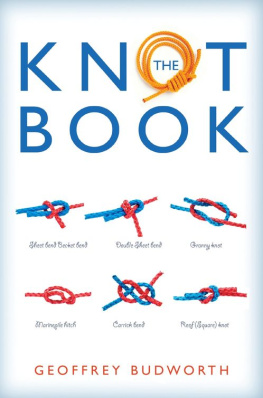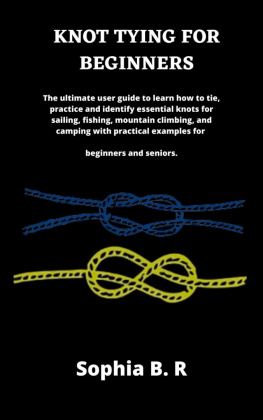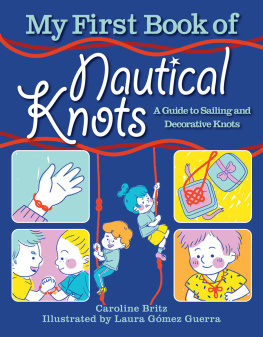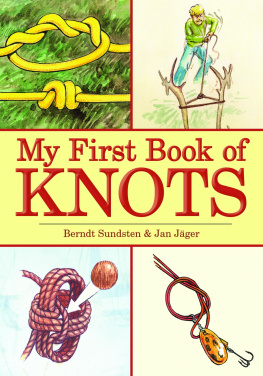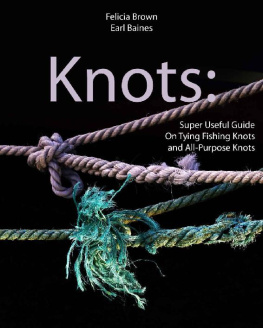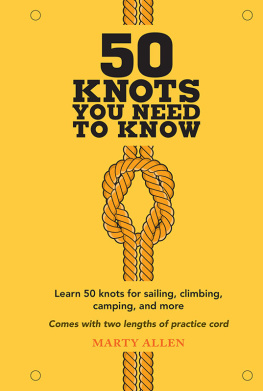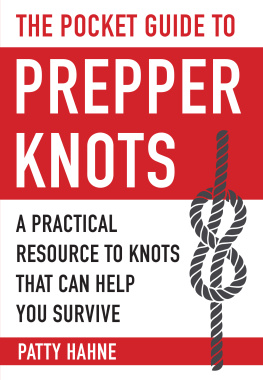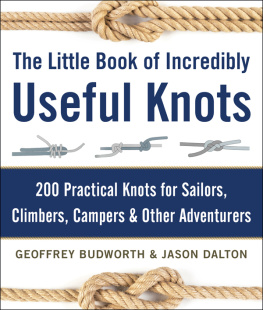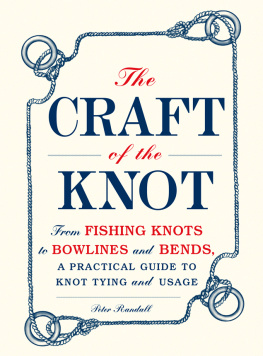Geoffrey Budworth - The Knot Book
Here you can read online Geoffrey Budworth - The Knot Book full text of the book (entire story) in english for free. Download pdf and epub, get meaning, cover and reviews about this ebook. year: 2012, publisher: Little, Brown Book Group, genre: Home and family. Description of the work, (preface) as well as reviews are available. Best literature library LitArk.com created for fans of good reading and offers a wide selection of genres:
Romance novel
Science fiction
Adventure
Detective
Science
History
Home and family
Prose
Art
Politics
Computer
Non-fiction
Religion
Business
Children
Humor
Choose a favorite category and find really read worthwhile books. Enjoy immersion in the world of imagination, feel the emotions of the characters or learn something new for yourself, make an fascinating discovery.
- Book:The Knot Book
- Author:
- Publisher:Little, Brown Book Group
- Genre:
- Year:2012
- Rating:4 / 5
- Favourites:Add to favourites
- Your mark:
- 80
- 1
- 2
- 3
- 4
- 5
The Knot Book: summary, description and annotation
We offer to read an annotation, description, summary or preface (depends on what the author of the book "The Knot Book" wrote himself). If you haven't found the necessary information about the book — write in the comments, we will try to find it.
The Knot Book — read online for free the complete book (whole text) full work
Below is the text of the book, divided by pages. System saving the place of the last page read, allows you to conveniently read the book "The Knot Book" online for free, without having to search again every time where you left off. Put a bookmark, and you can go to the page where you finished reading at any time.
Font size:
Interval:
Bookmark:
The list of contents at the beginning, in chapter and page order, will show you where to look for a history of ropemaking, techniques and terms, basic knots, string knots, more general knots, anglers knots, climbers knots, various other knots, new knots and trick knots.
A list of illustrations follows. If you know the name of a knot or a technique and want to see what it looks like, run your eye quickly down this list to spot the page you need.
If you know roughly what you want to achieve but dont know the right knot for the job look at the Knots, according to use section also at the front where you will find listed the names of knots for joining the ends of lines together; knots for attaching a line to a rail, post, another line, etc; knots tied in the ends of lines as stopper knots; binding knots; single loop knots tied in the end of lines; loop knots tied in the bight of lines without using ends; multiple loop knots tied in the end of lines for rescues, salvage, etc; and knots for various other purposes.
Knotting terms, where necessary, are fully explained in the text and also appear in a glossary at the end of the book.
To James Nicoll from Largo in the Kingdom of Fife, still the best knotsman Ive ever met, for his friendship and knowledge.
(Overhand Knot, Overhand Loop, Noose, Slip Knot, Packers Knots, Water Knot, Figure of Eight Knot, Figure of Eight Loop Knot, Flemish Bend, Phoebe Knot, Double Overhand Knot, Crossing Knot, Running Figure of Eight Knot, Crabbers Eye Knot);
(Span Knot, Snitch Knot, Weavers Knot).
t
KNOTS FOR JOINING THE ENDS OF LINES TOGETHER
KNOTS FOR ATTACHING A LINE TO A RAIL, POST, ANOTHER LINE, etc.
Fishermans Bend
Killick Hitch
KNOTS TIED IN THE END OF LINES AS STOPPER KNOTS
Double Overhand Knot
Figure of Eight Knot
Overhand Knot
Overhand Loop
Slip Knot
BINDING KNOTS
SINGLE LOOP KNOTS IN THE END OF LINES
N.B. Starred (*) knots are sliding loops which may be adjusted to size
Crabbers Eye Knot
Noose*
Overhand Loop
Packers Knots
Running Figure of Eight Loop*
LOOP KNOTS TIED IN THE BIGHT OF LINES
MULTIPLE LOOP KNOTS TIED IN THE END OF LINES
FOR RESCUES, SALVAGE, ETC.
KNOTS FOR VARIOUS OTHER PURPOSES
Crossing Knot (parcels)
Greef Knot (magic)
Phoebe Knot (craftsman)
Waggoners Hitch (truck drivers) 66,
No one can be wholly original on knots. Too many others have drawn and written about them. I gratefully acknowledge all those sources from which I have consciously or unconsciously acquired my knotting know how.
My thanks go to Mr J C Bates of British Ropes Ltd for bringing together publisher and author; and to Mr Peter Manners, the works manager, for his time and encouragement.
A number of friends within the International Guild of Knot Tyers have kindly given me permission to use their original ideas which I am pleased to portray and describe in print for the first time. I am especially indebted to Canadian climber and guide Bob Chisnall. My knowledge of climbers knots was largely learned from him. He is also a clever knotting innovator. The Double Hedden Knot is his variation of an established knot. Hunters Loop, the Adjustable Knot, and the Three Quarter Figure of Eight Loops are further examples of his inventiveness. The Double Munter Friction Hitch (which may also be called a Double Crossing Knot) is recommended as a climbers knot but so far only infrequently adopted by them. His Ontario and Algonquin Bowlines are experiments not in general climbing use and (it should be noted) may be regarded as new knots.
Its hard to choose from the many knots by Desmond Mandeville, but I unhesitatingly introduce his Tumbling Thief Knot to the knotting scene, together with the Poor Mans Pride and also Bend X. Ettrick W Thomson has contributed his method of tying the Poor Mans Pride.
Others to whom I am indebted for their own original material are my younger daughter Julie for Julies Hitch; Mr John Sweet, lifelong scout, knotting writer and authority on pioneering with ropes and spars, for his modification of the Waggoners Hitch with a strop; and Amory B Lovins who while working in Britain with Friends of the Earth Ltd pointed out to me the real origin of Hunters Bend for his Vibration-proof Hitch.
I gratefully acknowledge the generosity of Mr Spike Milligan for permission to reproduce his apt poem String at the beginning of Chapter 5. This poem originally appeared in Silly Verse for Kids by Spike Milligan, published by Penguin Books Ltd (1959).
My sincere thanks also go to Malcolm Elliot for his patience and editorial guidance; and to James Lester, illustrator, for his skill and tenacity in coping with my original drawings.
It is extraordinary how little the average individual knows about the art of making even the simplest knots. (R M Abraham 1932)
Imagine you are trapped on an upper floor of a burning building, too high to jump without serious injury. How can you improvise a rope? Tie bedsheets together and climb down them? Its been done but what knot should you use?
Have you ever taken trouble tying an awkward load onto the luggage rack of your car, only to have it shift dangerously after just a few miles? Do you continually stop to re-tie your shoe laces? Is it difficult to re-string your childrens musical instruments, or to make a parcel? Then you need to know the right knots.
We all have to fasten string or bandages sooner or later; and its knots that make them work. Housewives or DIY hobbyists, gardeners or modelmakers, there are the right knots for us all. Whether you are a parent trying to amuse a toddlers tea party, or a self-sufficiency exponent anxious to use the natural environment without depleting it, knots will help. You can learn to tie them at any age. One of the knots in this book was invented by a girl of nine years; others by a grandfather. Acquiring skill with knots can be good therapy for the sick and the mentally or physically handicapped, or simply an absorbing pastime.
Many people cope for a long time without knowing any really useful knots but only because they can replace them with handy manufactured fastenings like safety pins, dog lead clasps, snap-links, screws, glue, and those elastic cords with metal hooks on the ends. Now theyre fine when theyre available I use them all the time but without them youre lost, unless you can tie a knot or two. Knots are a useful alternative in many circumstances and indispensable in others. Thats why so many practical folk scorn spending money unnecessarily on gadgets and take pride in knowing the right knot for the job.
You dont have to like boats to enjoy knotting. Knot books tend to have a nautical flavour but that is only because old-time sailormen did more than any other group to develop practical knotting. Thus many knots and knotting terms are to do with ships and sailors. Dont be put off by that. The knots are just as useful ashore as they were afloat.
There are thousands of knots and an infinite number of variations of some of them. This book shows you about one hundred. The first half dozen or so are invaluable, used around the world by everyone who has to make rope, cord or string work for them. The wider selection that follows and the specialised needs of rock climbers and anglers have even been catered for are all very useful on occasions. Knots are like tools. You cant have too many; then you can always pick just the right one for the job.
(Incidentally, to tie those bedsheets together and so escape the fire, learn the Double Sheet Bend (fig. 14 CD) or the Fishermans Knot (fig. 15) or the Surgeons Knot (fig. 30).)
Font size:
Interval:
Bookmark:
Similar books «The Knot Book»
Look at similar books to The Knot Book. We have selected literature similar in name and meaning in the hope of providing readers with more options to find new, interesting, not yet read works.
Discussion, reviews of the book The Knot Book and just readers' own opinions. Leave your comments, write what you think about the work, its meaning or the main characters. Specify what exactly you liked and what you didn't like, and why you think so.

